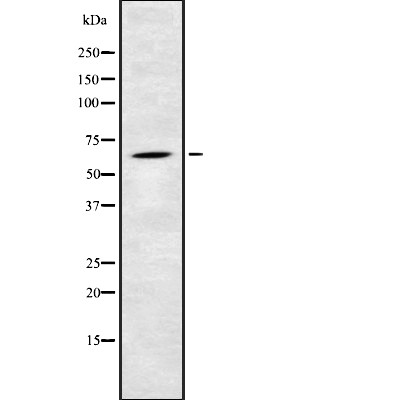AMPKgamma2 Antibody - #AF9006
| Product: | AMPKgamma2 Antibody |
| Catalog: | AF9006 |
| Description: | Rabbit polyclonal antibody to AMPKgamma2 |
| Application: | WB |
| Reactivity: | Human, Mouse, Rat |
| Prediction: | Pig, Rabbit, Dog |
| Mol.Wt.: | 65kDa; 63kD(Calculated). |
| Uniprot: | Q9UGJ0 |
| RRID: | AB_2843197 |
Related Downloads
Protocols
Product Info
*The optimal dilutions should be determined by the end user. For optimal experimental results, antibody reuse is not recommended.
*Tips:
WB: For western blot detection of denatured protein samples. IHC: For immunohistochemical detection of paraffin sections (IHC-p) or frozen sections (IHC-f) of tissue samples. IF/ICC: For immunofluorescence detection of cell samples. ELISA(peptide): For ELISA detection of antigenic peptide.
Cite Format: Affinity Biosciences Cat# AF9006, RRID:AB_2843197.
Fold/Unfold
5''-AMP-activated protein kinase subunit gamma-2; AAKG; AAKG2; AAKG2_HUMAN; AMPK gamma2; AMPK subunit gamma 2; AMPK subunit gamma-2; CMH6; H91620p; Prkag2; Protein kinase AMP activated gamma 2 non catalytic subunit; WPWS;
Immunogens
A synthesized peptide derived from human AMPKgamma2, corresponding to a region within N-terminal amino acids.
Isoform B is ubiquitously expressed except in liver and thymus. The highest level is detected in heart with abundant expression in placenta and testis.
- Q9UGJ0 AAKG2_HUMAN:
- Protein BLAST With
- NCBI/
- ExPASy/
- Uniprot
MGSAVMDTKKKKDVSSPGGSGGKKNASQKRRSLRVHIPDLSSFAMPLLDGDLEGSGKHSSRKVDSPFGPGSPSKGFFSRGPQPRPSSPMSAPVRPKTSPGSPKTVFPFSYQESPPRSPRRMSFSGIFRSSSKESSPNSNPATSPGGIRFFSRSRKTSGLSSSPSTPTQVTKQHTFPLESYKHEPERLENRIYASSSPPDTGQRFCPSSFQSPTRPPLASPTHYAPSKAAALAAALGPAEAGMLEKLEFEDEAVEDSESGVYMRFMRSHKCYDIVPTSSKLVVFDTTLQVKKAFFALVANGVRAAPLWESKKQSFVGMLTITDFINILHRYYKSPMVQIYELEEHKIETWRELYLQETFKPLVNISPDASLFDAVYSLIKNKIHRLPVIDPISGNALYILTHKRILKFLQLFMSDMPKPAFMKQNLDELGIGTYHNIAFIHPDTPIIKALNIFVERRISALPVVDESGKVVDIYSKFDVINLAAEKTYNNLDITVTQALQHRSQYFEGVVKCNKLEILETIVDRIVRAEVHRLVVVNEADSIVGIISLSDILQALILTPAGAKQKETETE
Predictions
Score>80(red) has high confidence and is suggested to be used for WB detection. *The prediction model is mainly based on the alignment of immunogen sequences, the results are for reference only, not as the basis of quality assurance.
High(score>80) Medium(80>score>50) Low(score<50) No confidence
Research Backgrounds
AMP/ATP-binding subunit of AMP-activated protein kinase (AMPK), an energy sensor protein kinase that plays a key role in regulating cellular energy metabolism. In response to reduction of intracellular ATP levels, AMPK activates energy-producing pathways and inhibits energy-consuming processes: inhibits protein, carbohydrate and lipid biosynthesis, as well as cell growth and proliferation. AMPK acts via direct phosphorylation of metabolic enzymes, and by longer-term effects via phosphorylation of transcription regulators. Also acts as a regulator of cellular polarity by remodeling the actin cytoskeleton; probably by indirectly activating myosin. Gamma non-catalytic subunit mediates binding to AMP, ADP and ATP, leading to activate or inhibit AMPK: AMP-binding results in allosteric activation of alpha catalytic subunit (PRKAA1 or PRKAA2) both by inducing phosphorylation and preventing dephosphorylation of catalytic subunits. ADP also stimulates phosphorylation, without stimulating already phosphorylated catalytic subunit. ATP promotes dephosphorylation of catalytic subunit, rendering the AMPK enzyme inactive.
Phosphorylated by ULK1; leading to negatively regulate AMPK activity and suggesting the existence of a regulatory feedback loop between ULK1 and AMPK.
Isoform B is ubiquitously expressed except in liver and thymus. The highest level is detected in heart with abundant expression in placenta and testis.
The AMPK pseudosubstrate motif resembles the sequence around sites phosphorylated on target proteins of AMPK, except the presence of a non-phosphorylatable residue in place of Ser. In the absence of AMP this pseudosubstrate sequence may bind to the active site groove on the alpha subunit (PRKAA1 or PRKAA2), preventing phosphorylation by the upstream activating kinase STK11/LKB1.
The 4 CBS domains mediate binding to nucleotides. Of the 4 potential nucleotide-binding sites, 3 are occupied, designated as sites 1, 3, and 4 based on the CBS modules that provide the acidic residue for coordination with the 2'- and 3'-hydroxyl groups of the ribose of AMP. Of these, site 4 appears to be a structural site that retains a tightly held AMP molecule (AMP 3). The 2 remaining sites, 1 and 3, can bind either AMP, ADP or ATP. Site 1 (AMP, ADP or ATP 1) is the high-affinity binding site and likely accommodates AMP or ADP. Site 3 (AMP, ADP or ATP 2) is the weakest nucleotide-binding site on the gamma subunit, yet it is exquisitely sensitive to changes in nucleotide levels and this allows AMPK to respond rapidly to changes in cellular energy status. Site 3 is likely to be responsible for protection of a conserved threonine in the activation loop of the alpha catalytic subunit through conformational changes induced by binding of AMP or ADP.
Belongs to the 5'-AMP-activated protein kinase gamma subunit family.
Research Fields
· Cellular Processes > Cellular community - eukaryotes > Tight junction. (View pathway)
· Environmental Information Processing > Signal transduction > FoxO signaling pathway. (View pathway)
· Environmental Information Processing > Signal transduction > AMPK signaling pathway. (View pathway)
· Environmental Information Processing > Signal transduction > Apelin signaling pathway. (View pathway)
· Human Diseases > Endocrine and metabolic diseases > Insulin resistance.
· Human Diseases > Endocrine and metabolic diseases > Non-alcoholic fatty liver disease (NAFLD).
· Human Diseases > Cardiovascular diseases > Hypertrophic cardiomyopathy (HCM).
· Organismal Systems > Aging > Longevity regulating pathway. (View pathway)
· Organismal Systems > Aging > Longevity regulating pathway - multiple species. (View pathway)
· Organismal Systems > Environmental adaptation > Circadian rhythm. (View pathway)
· Organismal Systems > Endocrine system > Insulin signaling pathway. (View pathway)
· Organismal Systems > Endocrine system > Adipocytokine signaling pathway.
· Organismal Systems > Endocrine system > Oxytocin signaling pathway.
· Organismal Systems > Endocrine system > Glucagon signaling pathway.
Restrictive clause
Affinity Biosciences tests all products strictly. Citations are provided as a resource for additional applications that have not been validated by Affinity Biosciences. Please choose the appropriate format for each application and consult Materials and Methods sections for additional details about the use of any product in these publications.
For Research Use Only.
Not for use in diagnostic or therapeutic procedures. Not for resale. Not for distribution without written consent. Affinity Biosciences will not be held responsible for patent infringement or other violations that may occur with the use of our products. Affinity Biosciences, Affinity Biosciences Logo and all other trademarks are the property of Affinity Biosciences LTD.
